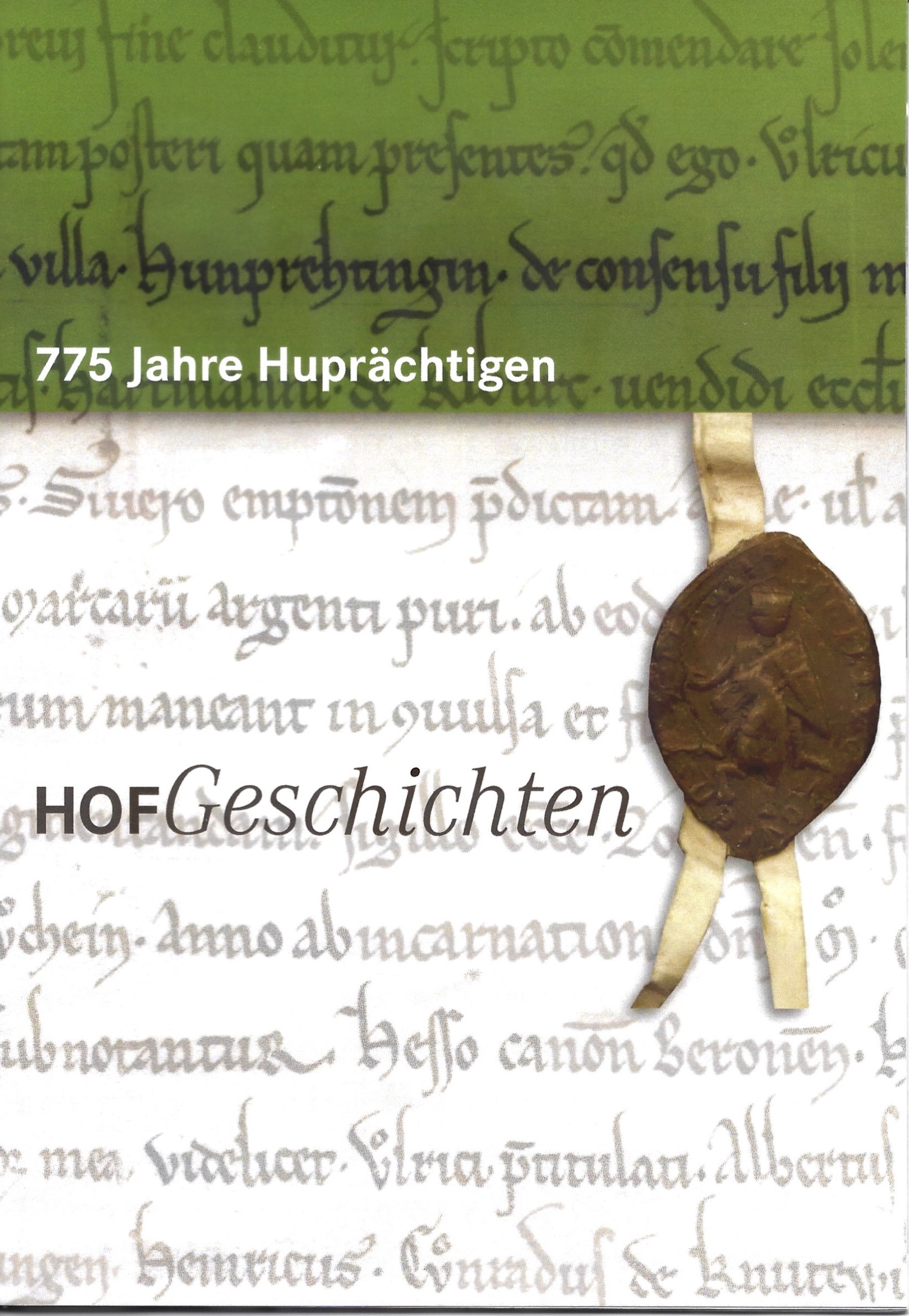

775 Years Huprächtigen
Farm Histories
Forward
Nottwil, 2011
HUPRÄCHTIGEN - a beautifully situated hamlet on the Nottwil Mountian, a name that stands for “makes itself good”, the stately farms with their exciting history, the annual meeting of the Huprächtigen people and last but not least the first mention in 1235 - is all that made us celebrate and write this book.
Many people still have fond memories of the 750th anniversary celebrations in 1985. These memories were the breeding ground and the motivation to organize a 775th anniversary celebration. Today we can say: It was worth it. On June 29, 2010 we were able to celebrate a wonderful festival with a church service, photo exhibition and good food with around 140 festival visitors, old and young, in beautiful weather. The festive mood was the barometer and a sign that the event had turned out very well. Many thanks to everyone, the organizing committee, the helpers and, last but not least, the festival participants! (Some pictures from this festival on page 21.)
The idea of this brochure on the farm stories came about during the preparations for the 775th anniversary celebration. On the one hand, we set ourselves the goal of exploring and showing where the name Huprächtigen comes from and what has happened to the homesteads over the years. The brochure is therefore divided into two main parts. The first, scientific part is designed by Josef Küng, Schüpfheim. He researched other sources in the Lucerne State Archives in order to make the history of those from Huprächtigen understandable. The scope of this brochure is not complete in all historical details and may invite further research. In his free time, Josef Küng did everything possible for him and presented the history of Huprächtigen vividly and interestingly. Thank you very much for your technically competent cooperation!
In the second part of the brochure, the current farm families tell their story, from the purchase of the property to the present day. These exciting stories allow an insight into the past. It is not a matter of course that the families share their interesting and personal stories with us. We would like to thank all of the writers for this openness.
A central place for the Huprächtigen farmers was the cheese dairy. Old documents, minutes of meetings, annual accounts and more would provide extensive material for a review. Originally cheese was made on the Weingartner family's farm and later on the Krummenacher family's farm. The present dairy building was built in 1928 by the Huprächtigen farmers. Emmental cheese was produced there until 2002. The changes in the dairy industry meant that cheese-making on Huprächtigen was abandoned. Since then, the milk has been taken from the farms and processed by the Emmi company. The dairy cooperative sold the dairy building to Yolanda and Otti Birrer in 2004.
Demographically, the living culture has changed significantly in the last few decades for Huprächtigen people. While large families and servants and maidservants lived on the farms in the past, these are now run as family businesses. In many places, structural change has created free living space. Over the past ten to twenty years, vacant rooms have been turned into apartments or even a small Stöckli built in some places. Where this living space is not occupied by family members, it is rented out. The “Meierisliy” is an exception. In 1957 the land was parceled out for the Meierisliy and the Estermann family built their home on this parcel. At that time, spatial planning still made such buildings possible.
A list of names can be found at the end of this brochure. It provides information about which residents are currently living in Huprächtigen.
Dear Readers: We hope that this brochure offers a lot of interesting information and also some entertainment.
January 2011, Pius and Toni Weingartner
A Historical Overview
In the municipality of Nottwil there are a number of properties that bear the name Huprächtigen; some are farms, some are individual houses. In addition to Huprächtigen people themselves, there are combinations of names such as upper, middle, lower, chili and new Huprächtigen people.
Today the area of Huprächtigen can be precisely defined: the residents are known by name; the individual possessions are precisely measured; the use of each individual parcel is recorded. - as we look back a few centuries in the following, we would do well to break away from this precision today: In the beginning, Huprächtigen was an area name that did not have the current discriminatory power. Who lived here, what belonged to whom, what was cultivated, what the landscape looked like, what buildings there were and where they were - that can at best be reconstructed more or less reliably for the last two or three centuries.
The present essay tries to show the broad lines. Undoubtedly, based on the good sources - especially for the more recent times - the development of Huprächtigen could be worked out more precisely. Perhaps this little script will encourage a future researcher to do it.
First mentioned 775 years ago
Huprächtigen is mentioned for the first time in 1235 - and this twice in documents from the Benedictine monastery Engelberg. The first dates from April 21, 1235: Knight Ulrich von Büttikon sells his possessions in Huprächtigen to the monastery (... omnes possessiones meas, quas habui in villa Hunprehingin ...). - See picture on page 6.
In the same year Johannes von Hildisrieden transfers his property in Huprächtigen to Engelberg Monastery and receives it back in return for interest as an inheritance (... predium meum in Huprehingin contuli monasterio Montis Angelorum et recipi iure heriditario). Should he die childless, the possessions would go completely to the monastery. '
These two documents from Engelberg Monastery and thus the first mention of the name Huprächtigen are also mentioned in the source work on the creation of the Swiss Confederation 2. For the 13th and 14th centuries this gives a whole series of other documents; some examples from this:
- In 1251 the Beromünster year book mentions the estate in Huprechtingen;
- In 1260, priest Rudolf von Wile, canon of Zofingen, gave the Church of St. Urban from his Schupossen de Huprethtingen;
- In 1273 the Johanniterhaus in Hohenrain transfers the possessions in Hupprahttingen to Ulrich von Nottwil;
- In 1279 Wernher de Hubechtingen appears as a witness in a legal dispute; 1289 Wernherus de Hupprechtingen, 1311 Chuonradus de Hupprechtingen. The same appears several times at the beginning of the 14th century, as does Jacob von Hubrechttingen.
- In 1324 the Anniversarurbar of the Canons of Beromünster mentions an estate in Huprechtingen that Uolricus built on the Buele.
- Huprächtigen is mentioned several times in the year book of the Parish Sursee, whose oldest entries date back to 1359. Here we meet Burkard in the bach de hupprechtingen et mehthild uxor sua (... and Mechthild, his wife); Hemma Imbach von Hupprechtingen, Johann meyer de hubrechtingen or Berchta de hupprechtingen dicta meyerin (called meyerin).
One Farm Becomes Several
Even in the 15th and 16th centuries, people from Huprächtigen and residents of the area are frequently mentioned; for example in the year book Ruswil from 1488, in the fodder oat book of the city of Lucerne (approx. 1495) or in connection with border disputes between the offices of Ruswil and Rothenburg or the Michelsamt. 3 Several times there were disputes about whose territory Huprächtigen was located, for example in 1424 or 1535. That year, “those of Rothenburg and Ruswil (...) agreed that the two farms of Huprechtingen and Windblasen should be assigned to those of Ruswil ». * - Apparently Huprächtigen was a single farm at that time.
From the 17th century onwards, the ownership structure in Huprächtigen can gradually be reconstructed; more detailed research into the archives would certainly reveal more details. Only one mortgage note from Hanns Meyer from 1630 and another from Hans Ulrich Meyer from 1666 should be mentioned here. 4 In 1668 Judge Walter Meyer took possession of two farms in Huprächtigen; they comprised 200 Jucharten land and 28 Jucharten forest.
From Meyer to Hüsler
In 1692 Meyer sold the two Upper-Huprächtigen farms for 26,000 guilders to the wealthy Hüsler family from Rickenbach; Descendants of this family still live in Huprächtigen today. In 1709 and 1713, Hans-Jakob Hüsler and his four sons bought the two homesteads, Lower-Huprächtigen; they now owned almost the entire Huprächtigen area. In 1734, members of the Hüsler family built the stately baroque house, today owned by the Weingartner family, Middle-Huprächtigen. 6 In the late 18th and 19th centuries, the property in the Huprächtigen area gradually split up, with the Hüsler families continuing to play a leading role . There is an interesting note in the division protocol from 1781, when Jakob, Leonz and Franz Hüsler shared the property of the late Jakob Hüsler: Of the 162 Jucharten land, 30 are referred to as Mattland, 132 as Weidland. Claus Niederberger (see note 6) writes about this: “This shows that the transition to cattle breeding and dairy farming had already been made and completed here in the 18th century. That this type of cultivation has not existed since time immemorial is proven by the traditional interest, which was mostly still calculated with grain, and also the earlier protocols, which all include fields and a granary in addition to pastures and meadows.”
Smaller Farms, New Names
In 1799 there were only three farms in Huprächtigen that were subject to interest; this is evident from the list of land interest rates in the gmein Notwill. 7 The three farms covered a total of 291 Jucharten; they belonged to Augustin Hüsler, Franz Hüsler and Jacob Hüsler.
How these possessions continued to divide over the next hundred years could be determined in detail on the basis of purchase and partial letters as well as validities. The cadastral registers of the municipality of Nottwil from the years 1823, 1868, 1888 and 1908 provide a good overview
In the cadastre from 1823 a total of five properties called Huprächtigen with around 290 Jucharten are listed. The largest farm (127.5 Jucharten) belonged to Josef Meyer at the time. Another farm of 87.5 Jucharten belonged to the "Brothers Hüsler des Franzen" and a farm of 61 Jucharten belonged to Leonz Hüsler. For the first time, two small Heimwesen appear: that of Josef Troxler with 8 Jucharten and that of Alois Stauffer with 5.5 Jucharten.
The cadastral books from 1866 to 1908 list six properties with a total size of approx. 240 Jucharten or 85 hectares. From the mentioned farm of Josef Meyer two equally large farms named Upper-Huprächtigen emerged; in the meantime they belonged to a family named Käch and today they belong to the Huber and Krummenacher families.
There were major shifts in the area that was called Middle-Huprächtigen from 1888 onwards. Part of it (approx. 38 Jucharten) came into the possession of the Weingartner family in 1873. The greater part remained in the hands of the Hüsler families or passed to them, such as Middle-Huprächtigen (20 hectares) and Lower-Huprächtigen (5 hectares). The current names LaRGE- and New-Huprächtigen came about later. The smallest of all Huprächtigen properties, today's Chli-Huprächtigen, has had an eventful history and has always had different owners.
In the Huprächtigen-Farm area there is, on the one hand, an impressive level of constancy; some families have been settled here for many decades - in the case of the Hüsler family for several centuries. But there were and are also changes: over the centuries, “territory” was lost to neighboring farms, for example to the neighboring Stockschürli properties or to Farm Fluss, which was built in the 19th century. Conversely, “Stockschürli” land has recently been cultivated from Huprächtigen.
Huprächtigen - this name has been tangible for almost 800 years. For many centuries this area became home to many people. How the current owner families came to Huprächtigen and how they designed this living space, they describe themselves in the following six articles.
Josef Küng
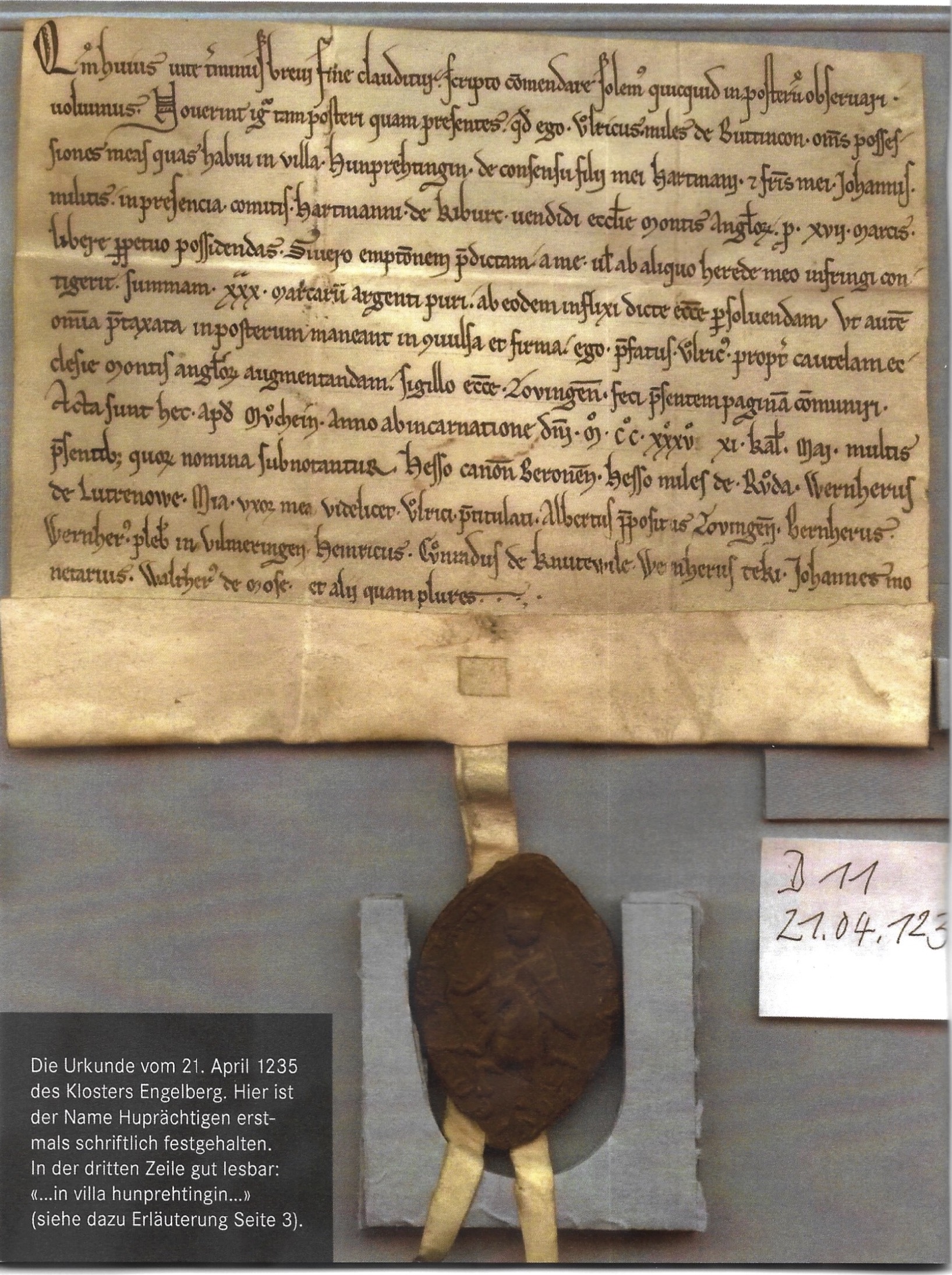
The document of April 21, 1235 from Engelberg Abbey. Here the name Huprächtigen is recorded in writing for the first time. Easily legible in the third line: "... in villa hunpdrehingen ..." (see explanation above).
The name Huprächtigen
As different as the spellings of the name Huprächtigen are - for name research the facts are clear: Huprächtigen belongs to the group of Alemannic names. Other examples in the area include: Sigigen and Dieggringen (municipality of Ruswil); Trutigen, Rüeggeringen and Werligen (Neuenkirch municipality) or Renzligen (Oberkirch municipality). Place names of this type are common in the Swiss Plateau. Ingen names are so-called inmate names. In the first part of the name there is usually an Old High German personal name; this person can no longer be recorded in a document, perhaps it was the founder of the farm himself or the farm owner. The ending -ingen can be translated as "with the people of ...". So Huprächtigen means: With the people of Huprecht (or at best Hunprecht).
1 Information on these two documents from Rolf de Kegel, archivist of the monastery Engelberg.
2 Source work on the creation of the Swiss Confederation. Documents, chronicles, court rights, Rödel and year books up to the beginning of the 15th century, Aarau 1933ff.
3 More on this in: Glauser / Siegrist: The Lucerne Parishes and Bailiffs. Lucerne / Munich 1977. (Lucerne Historical Publications Volume 7)
4 Lucerne State Archives, PA 672/77.
5 Lucerne State Archives, file 11R / 1069.
6 Further information on the end of the 17th and 18th centuries in: Claus Niederberger, The restoration of the Mittler-Huprächtigen court in Nottwil, Yearbook 11 of the Lucerne Historical Society, 1993.
7 Lucerne State Archives, file 27 / 4D.2.
8 Lucerne State Archives, CA 66; CA 332; CA 472; CA 765.
Upper-Huprächtigen, Huber Family
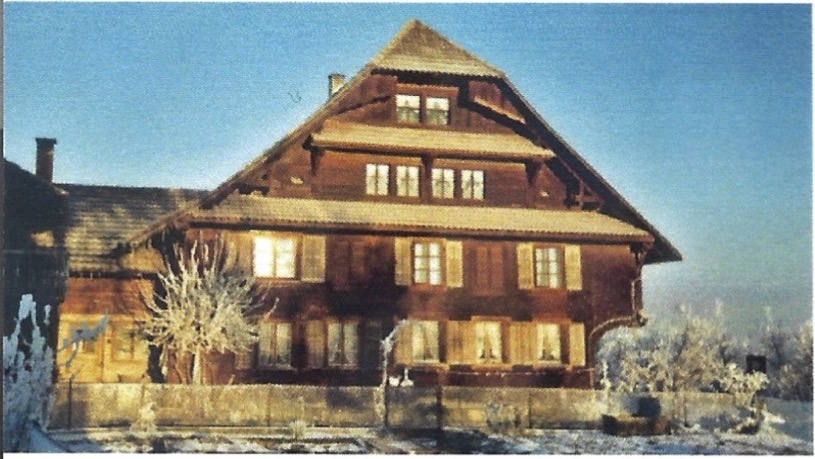
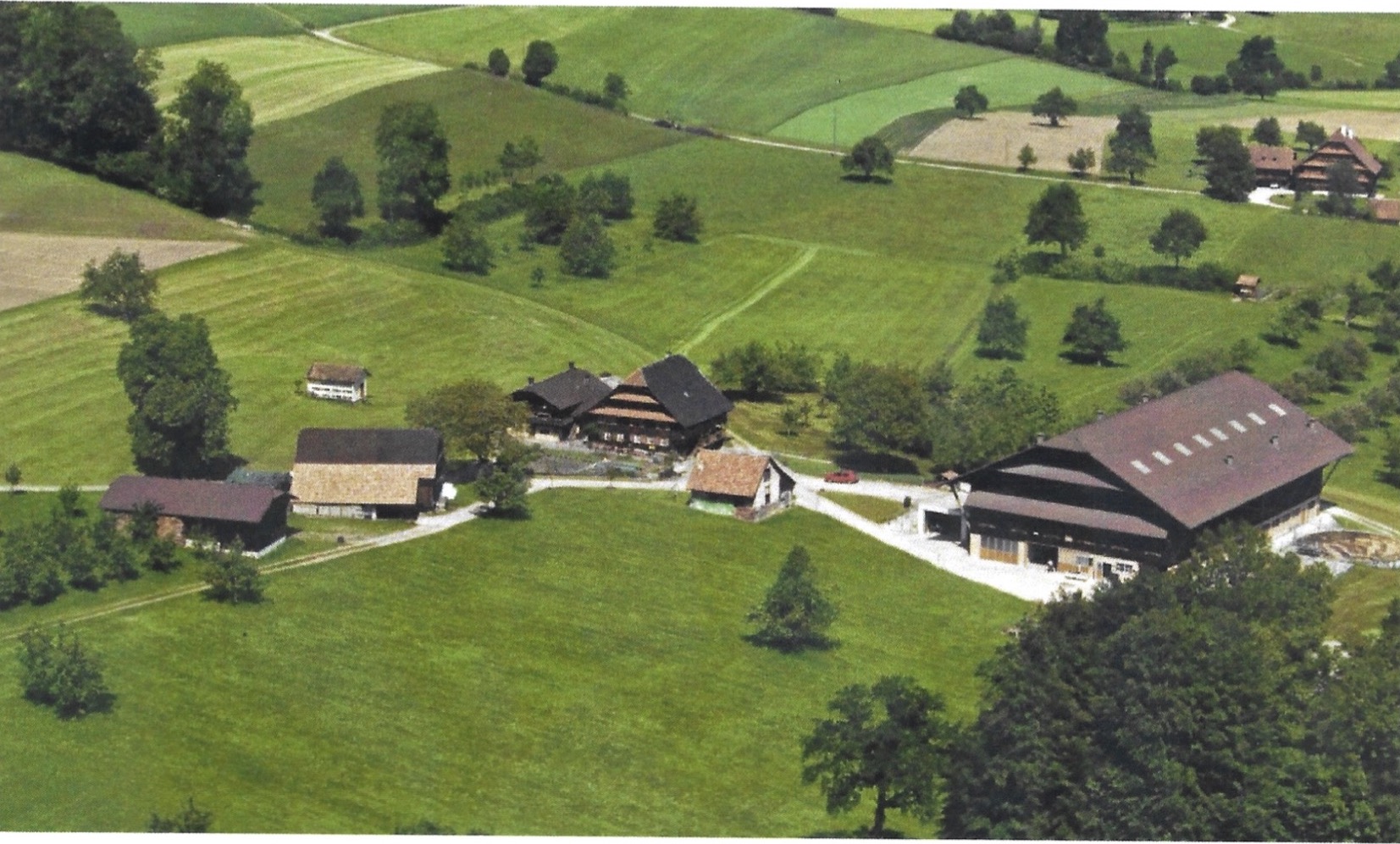
The Upper-Huprächtigen property was bought by Konrad Huber-Frei from Franz-Josef Käch on April 3, 1899. Buyer Konrad Huber had previously managed the Gabrielhüsern farm in Buttisholz together with his six sons and a daughter. Father Konrad moved to Upper-Huprächtigen with three sons Anton, Franz and Konrad. The mother stayed with the other children on the Gabrielhüsern farm.
Anton Huber later took over the farm and married Agatha Ackermann of Grosswangen. They had five children. At this time, the customs in Upper-Huprächtigen were strongly maintained. There was a Santa Clause party, hostages and carnival was important to them.
In 1938 Anton and his wife Marie Jost of Oberkirch took over the farm. The two had married in 1928. They also rely on the tried and tested and successfully run dairy farming and cattle breeding. Anton loved horses very much and was a farmer with body and soul.
In the thirties and forties, the farm forge was an important point of contact, also for the surrounding farms. A farrier worked in the forge, his name was Franz Bruger. A Wagner by the name of Graber also worked with him in this old Spycher, which is still standing today. Later the forge was run by August Wermelinger. He lived with his family on the farm of the Krummenacher family. His successor was an employee of Ferdinand Meier, master blacksmith in Neuenkirch. The last professional in the old forge was Hanspeter Büchler. He worked there as a blacksmith.
The marriage of Anton and Marie Huber-Jost gave birth to four children: Marie, Anton, Werner and Walter. Anton Huber married Hedi Frei von Ruswil in 1959. The two ran the farm together with Werner and in 1968 they took it over from their parents. They too ran the farm with body and soul, rearing cattle, farming and dairy farming. In addition to horses, cattle shows were very important to them. Anton and Hedi gradually had a handsome family: Peter, Toni (he died at the age of four in a logging accident), Hedi, Franz, Anton and Beatrixe.
In 1986 Peter Huber and Monika Amrein of Schwendi married. This marriage had five children: Patrick (he died in 1992), Rolf, Marcel, Doris and Lukas. In 1998 Peter and Anton were able to take over the farm from their parents and Uncle Werner Huber. Dairy farming, arable farming and pig breeding are still the most important branches of the business.
On the night of March 13-14, 1999, the barn burned to the ground. The cattle and belongings were rescued by the Nottwil fire brigade and the paraplegic center. Six months later, on November 21st, the new and modern barn was presented to a wide audience. The new barn was turned 90 degrees to the old barn. It has a footprint of 41.5 x 25 meters and the outer walls are raised in two-shell masonry. There are three hay boxes on the second floor. The roof is supported by seven girders with a span of 31 meters. A grass silo was not built, as the milk was still being processed into Emmental cheese by the Huprächtigen cheese dairy. The exciting year 1999 ended with cyclone Lothar, which destroyed around three hectares of forest.
Today the older children are already doing an apprenticeship and one son has completed an agricultural apprenticeship. Who knows, maybe he will follow in the footsteps of his ancestors ...
Monika and Peter Huber-Amrein
Anton Huber
Business
Area: cultivated land 24 ha; Forest: 4 ha.
Use: meadows 20.2 ha; Arable land 4 ha; 110 standard trees.
Animal husbandry: 37 dairy cows; 24 young cattle; 16 mother sows.
Middle-Huprächtigen, Krummenacher family
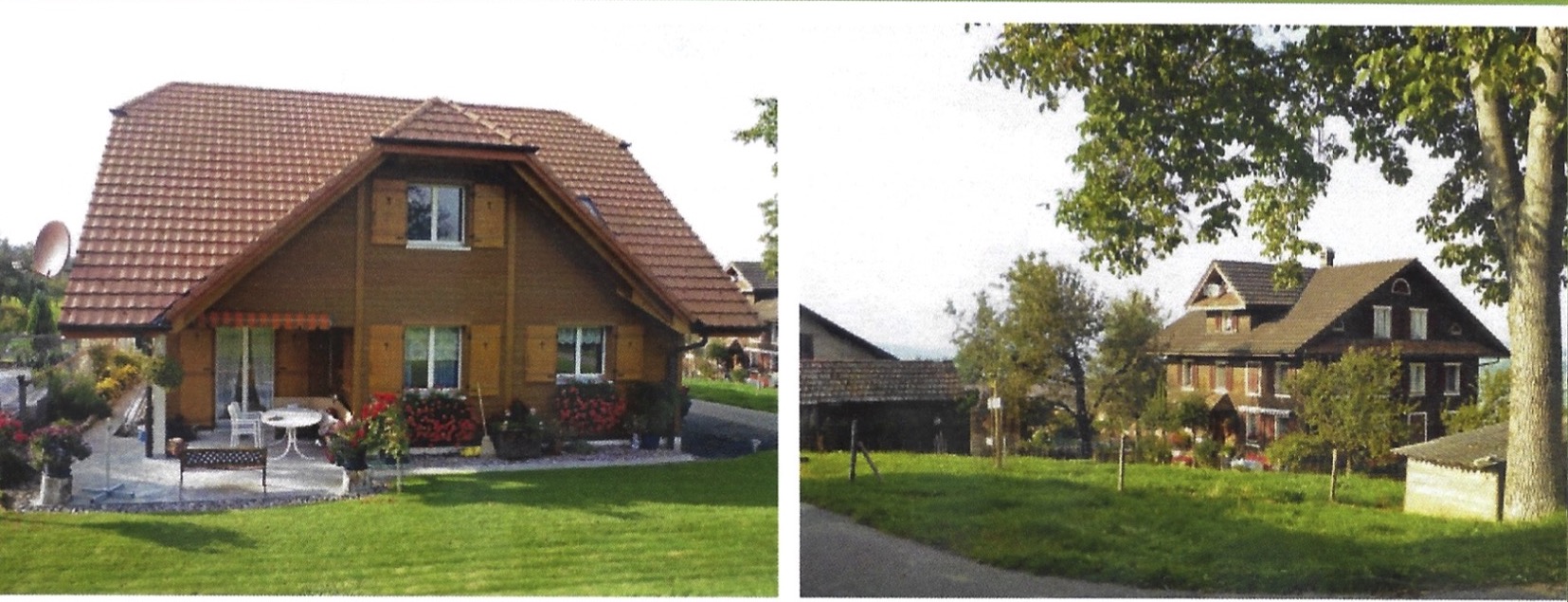
Our farm belonged to the Upper-Huprächtigen property, which was managed by Josef Käch. In 1865, Käch built our farmhouse. When the barn was built is not known exactly, around 1870. At that time, Käch moved to the Middle-Huprächtigen farm and sold Upper-Huprächtigen.
60 Jucharten land and 15 Jucharten forest belonged to Middle-Huprächtigen, which was quite a large operation for the time. Ten years later this farm was sold to Ehret and again ten years later to August Küng. At the beginning of 1930, Julius Krummenacher bought the Middle-Huprächtigen farm from his predecessor August Küng. On March 1, 1930, father Julius Krummenacher moved with his wife Nina Krummenacher-Brunner and their five children from Rothenburg (Ottenrüti) to Huprächtigen.
Cheese was produced in the former old cheese dairy building next to the farmhouse until 1928. The Kohlholz farm, which was remote at the time, and the Grundacher farm also delivered their milk to Huprächtigen. The last cheese maker was called Hans Künzli, he was the grandfather of the former landlord in the Nottwil restaurant Bahnhof.
A chapel also belongs to this Huprächtigen property. This is said to have been built to protect against the Türst (a diabolical spirit) that was up to mischief during this time. The year of construction is unknown. A small metal cross with a rosette instead of a corpus is attached to the ridge. The late Gothic figures of God the Father and the Son of God and also the image of Our Lady with the inscription "Maria Hilff 1852" disappeared one day. They are supposed to have been sold to Jews. As a result, the farmer K. made unpleasant acquaintances with the Türst. He could no longer go to the chapel. A neighboring farmer advised him to buy the picture back. This way he could put the picture of Our Lady back in the chapel. This is what the legend according to Cysat describes ("The wild hunt in the canton of Lucerne around 1600") this was passed on to our ancestors.
In 1999 the storm Lothar destroyed the chapel, only the image of the Virgin was spared. The following year our sons rebuilt the chapel. In 2002 it was inaugurated by Pablo Meier (Pastor of Nottwil). As a great recognition of the community, we were presented with the first Nottwil Culture Prize at the beginning of 2002.
When Father Krummenacher came to Huprächtigen, a difficult time began for him. In the 1930s there was a major crisis in agriculture. The diseases of the cattle in the stable and the death of his 40-year-old wife and mother of six children (1931) also bothered him very much.
In 1933 father Julius Krummenacher married Frieda Willimann from Dagmersellen. The six small children found in her a good mother again; she gave birth to two more children, Frieda and Toni.
Josef Schaffhauser also moved to Nottwil with his uncle. He did most of the work in the field with his two horses and an ox. He was known everywhere as Seppi Schaffhuser for his humor and his joy in dancing. In 1981 he died of cancer at the age of 75.
On Sundays, Julius Krummenacher always drove to church with his horse and chaise (car with a top). When the Rossstall at Gasthaus Krone was demolished, he bought his first car, the Vauxhall brand, in 1952.
The first telephone was installed around 1930. From then on, the neighbors could also make use of it. The arrival of the first tractor, Porsche brand, was in 1965. Smaller jobs are still carried out on the farm with this tractor.
Father Julius Krummenacher was known everywhere with his distinctive mustache; he died in January 1967. At this time, the youngest son Anton took over the farm; he married Annamarie Schmid of Meggen in 1968. Between 1969 and 1984 Anton and Annamarie had five sons: Toni, Urs, Rene, Adrian and Andreas.
On August 11, 1996, our dear grandiose and Gotti Frieda Krummenacher fell asleep forever at the age of 94 at home with Huprächtigen people.
With the marriage of son Toni and Monika Bähler of Rain in 2006, a new generation took over the farm again. In 2009 Toni and Monika's son Michael was given it as a present.
With the takeover of the farm, structural changes were also pending. In 2005, a new two-family farmhouse was built above the street and the old one next to the barn is now used as a Stöckli.
Just as his father Anton converted the pig barn in 1975, son Toni enlarged the pig barn in 2009 and 2010 and adapted it to the new regulations. He mainly breeds pigs, but continues to do dairy and arable farming.
Family Krummenacher
Middle-Huprächtigen, Weingartner Family
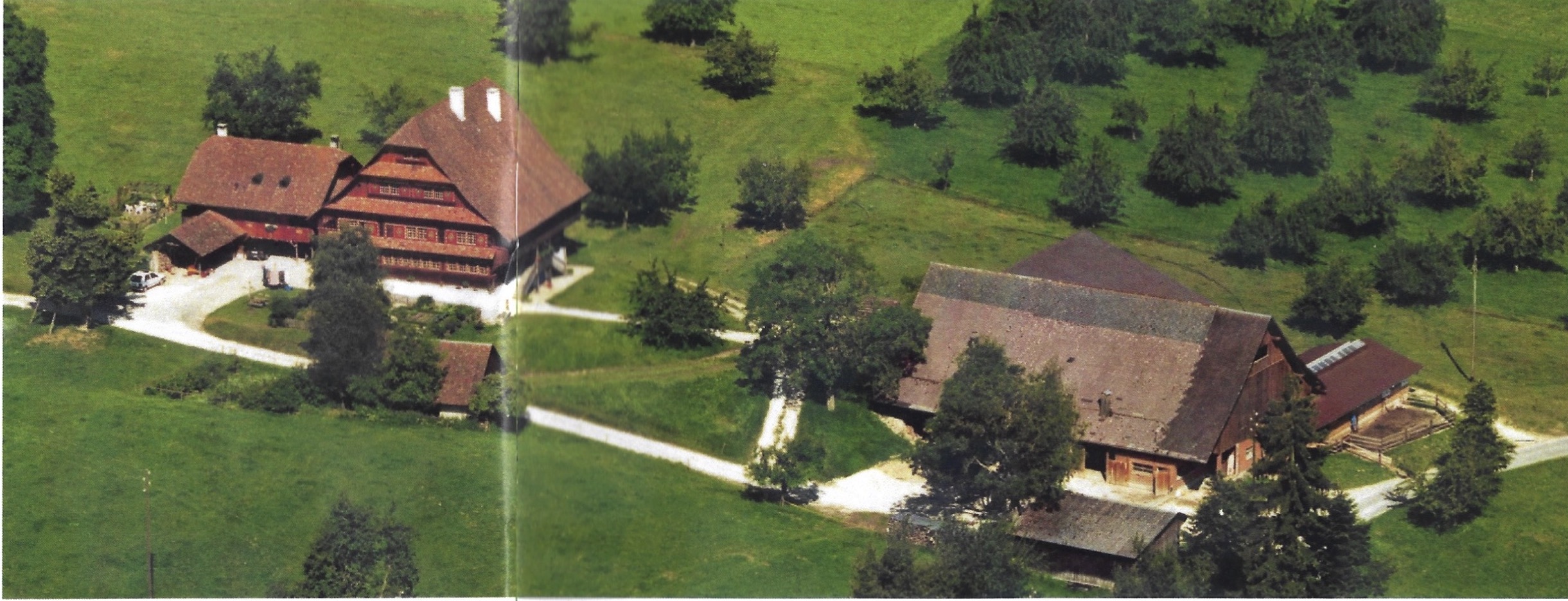
The Melchior Weingartner of Sempach family bought the Middle-Huprächtigen farm from August Burkhard in 1873. Previously, Josef Hofer was the owner, who had acquired this farm from Johann Hüsler in 1837.
Melchior, who died in 1874, and Rosa Weingartner-Schnieper had three sons and two daughters. Melchior, born in 1848, became his successor and married Josefa Schmidli from Malters in 1881. Our grandfather, our son Melchior, born in 1882, had three sisters and a brother who died early. In 1914 he took over the farm for a purchase price of 65,000 francs. In 1916 he married Marie Egli from Figlisberg. Our father Anton Weingartner was born in 1919; he had three younger brothers and three younger sisters.
Like many other farmers, the Weingartner-Egli family went through difficult times in the 1920s and around 1932 because of the economic crisis. As a debt enforcement officer, our grandfather had the difficult task of finding acceptable solutions for creditors and debtors when prices were rock bottom and at 4.5 percent debt interest. In 1936 the economic situation improved, but with the outbreak of the Second World War, difficult times arose again.
In 1928 our grandfather made land available for the new cheese dairy that was to be built at an advantageous price. In 1958, thanks to the generous attitude of our grandfather, the long-time employee Kaspar Estermann was also able to acquire a piece of land and build the "Meierisli".
The young years of our father Anton Weingartner were shaped by the happy family, but also by the hard times mentioned. After 1945 things slowly improved and in 1956 he was able to take over the farm. In 1958 our father married Maria Rebsamen of Rothenburg. Together they tackled the challenge energetically and experienced the great upheaval towards the mechanization of agriculture. In the 1960s, tractors and loading wagons were purchased and a new cowshed was built. The family flourished and had four daughters and four sons: MariTheres, Toni, Rita, Pius, Guido, Thomas, Ruth and Irene were born between 1959 and 1971. We experienced a lot of beautiful things together, not least because of the generous hospitality of our parents. In 1983 our mother died much too early after a serious illness at the age of 52. Thanks to our solidarity, we were able to master this difficult time together.
Our father took an active part in social life all his life, including as President of the Nottwil Church Council. Even after the farm was handed over, he still worked actively. He died in 2000 at the age of 80.
In 1988 the business was handed over to the eldest son Toni. The listed building was restored in 1989/90. In 1990 we married Toni Weingartner and Helene Ottiger from Rothenburg. In 1992 our twins Vera and Selina saw the light of day; Lucia (1996) and Andreas (2000) complete our family. Vera is doing her apprenticeship as a cook, Selina and Lucia attend the canton school in Sursee and Andreas is in the 5th primary class.
The farm has continued to develop in recent years. In 1994 we built a stable for 24 mother pigs, and in 1998 the cowshed was converted into a playpen. At the moment the planting of one of the table cherries is imminent.
Helene and Toni Weingartner-Ottiger
Business
Area: cultivated land 13.5 ha; Forest 2 ha.
Use: 11 hectares of meadows; 2 hectares of arable land; 0.5 ha table cherries; 100 standard trees.
Animal husbandry: 21 dairy cows, 5 young cattle, 24 sows.
Large-Huprächtigen, the Hüsler family
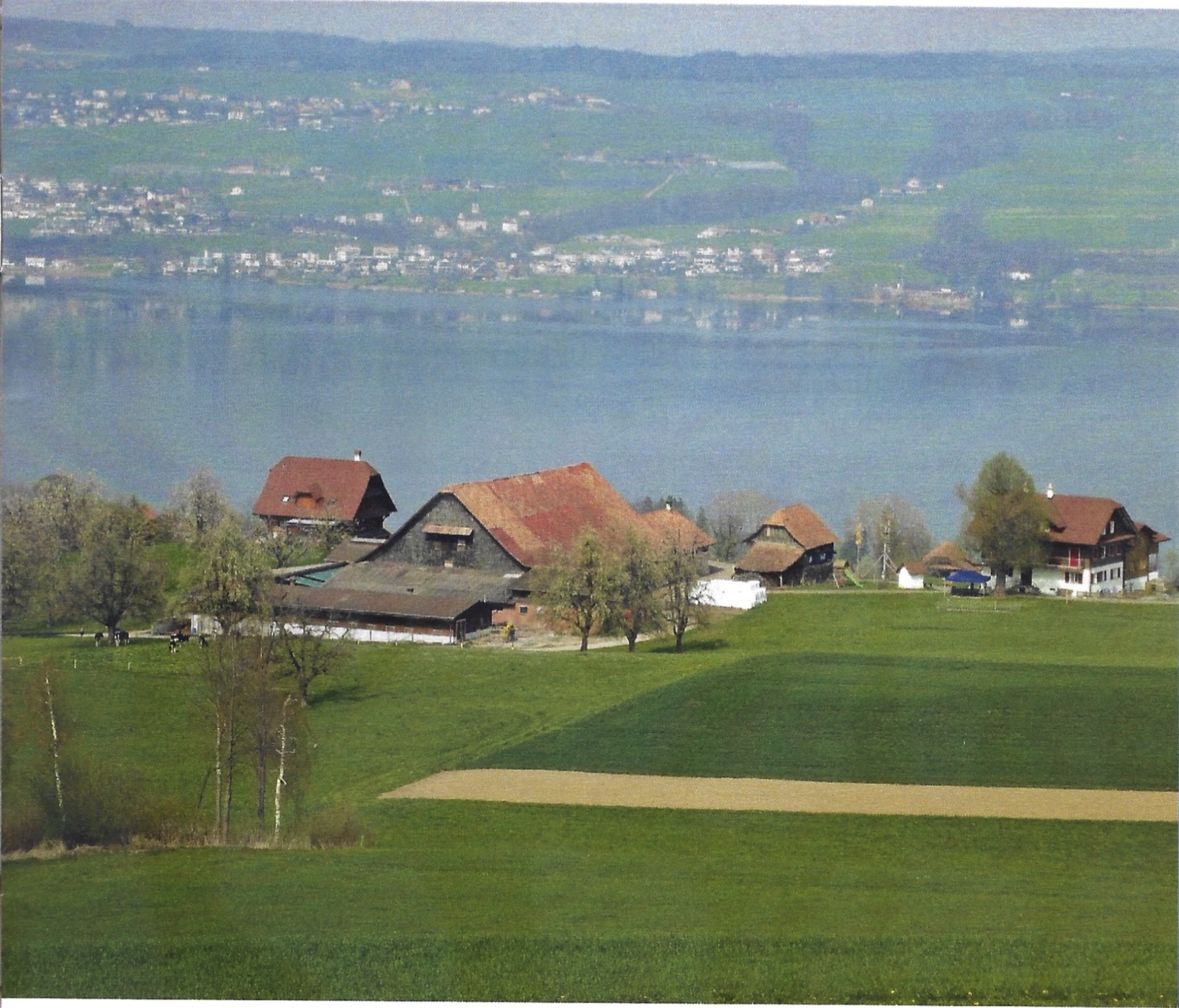
In 1692 Jakob and Niklaus Hüsler moved from Rickenbach to Huprächtigen, Nottwil. They bought "two husks, stoves, spicher and land" at a price of 26,000 guilders. In 1709 and 1713 they bought additional farms. Our Spycher bears the year 1678.
There is a Trinity Chapel next to the Spycher. It was built in 1747, according to legend because of an epidemic, by Jakob Hüsler, born in 1702. The oak buffet in our room bears the year 1773 with engravings by Jakob Hüsler and Annamarie Leu.
Jakob, born on September 14, 1736, took over the farm from this family and married Kostantina Schüpfer in 1775. Together they had 15 children. From these, Lorenz, born in 1785, took over the farm. He married Elisabeth Marbacher in 1819.
Her son Jakob, born in 1823, married Verena Kaufmann in 1858, he was a farmer, church manager and councilor. His successor Anton Hüsler, born in 1868, married Katharina Estermann of Hildisrieden in 1900. He was a parish administrator and church manager.
The sons Kaspar, born on January 30, 1901, and Anton, born on February 15, 1902, took over the farm at an early age. Kaspar married Martha Fleischlin of the Wenischwand, Sempach, in 1928; Anton married her sister Marie Fleischlin in 1930. He was a mayor. Of the two families, 15 children grew up in the same household.
In 1960 a new settlement (New-Huprächtigen) with a house, pigsty and barn was built on the property. Josef, Kaspar's son, moved to the new settlement. Anton, born on March 25, 1934, son of Anton, stayed on the Huprächtigen farm, as did his cousin Hans, son of Kaspar Hüsler.
On September 27, 1966, Anton Hüsler and Margrit Burri married. They have seven children together: Margrit, Toni, Daniel, Bruno, Priska, Roland and Gerda. In 1973 they took over the farm. The next major investment was the construction of the pig barn. In addition to dairy farming and fruit growing, pig breeding became more and more important.
In 1979 the opportunity arose to purchase the Stockschürli property. Anton and Hans Hüsler acquired these in equal parts. Thus the dairy industry could be increased.
The sons Toni and Daniel completed their agricultural training and worked on the farm from 1986. Ten years later they were able to lease the farm. Little by little, the siblings moved away from home and started their own household. The parents realized the new building of their Stöckli. Toni passed the master craftsman's examination and Daniel took further training in fruit growing. In 2000 they were able to buy the farm. With the new construction and renovation of the pigsty in 2000 and the construction of the pen for the cows in 2003, the company was modernized.
Daniel Hüsler and Vreny Steiger married on September 18, 2004. In 2005/06 the farmhouse was rebuilt. This resulted in two apartments and a small attic apartment for Hans. In 2006 and 2009 Daniel and Vreny became the happy parents of Petra and Manuel. The foundation stone for the eleventh generation has been laid.
The Hüsler Family
Business
25.63 hectares of usable agricultural area 7 hectares of arable land; 4.3 hectares of forest
34 dairy cows with rearing
70 sows
210 standard trees
30 aren plum plant
New-/Lower-Huprächtigen, Hüsler Family
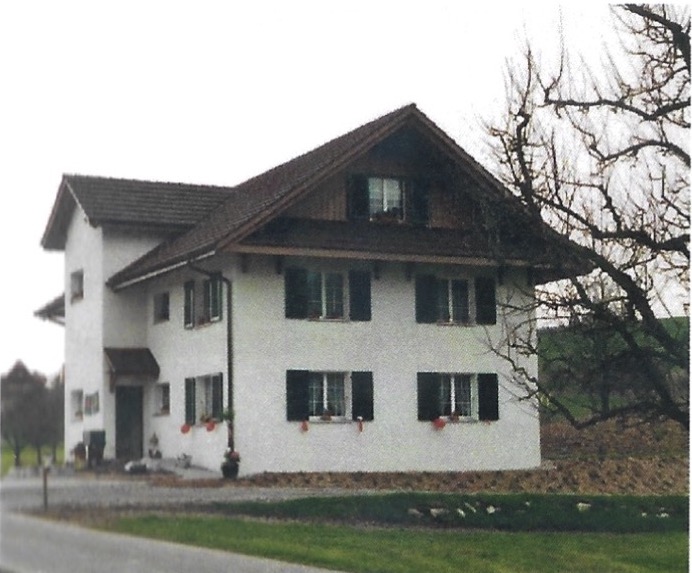
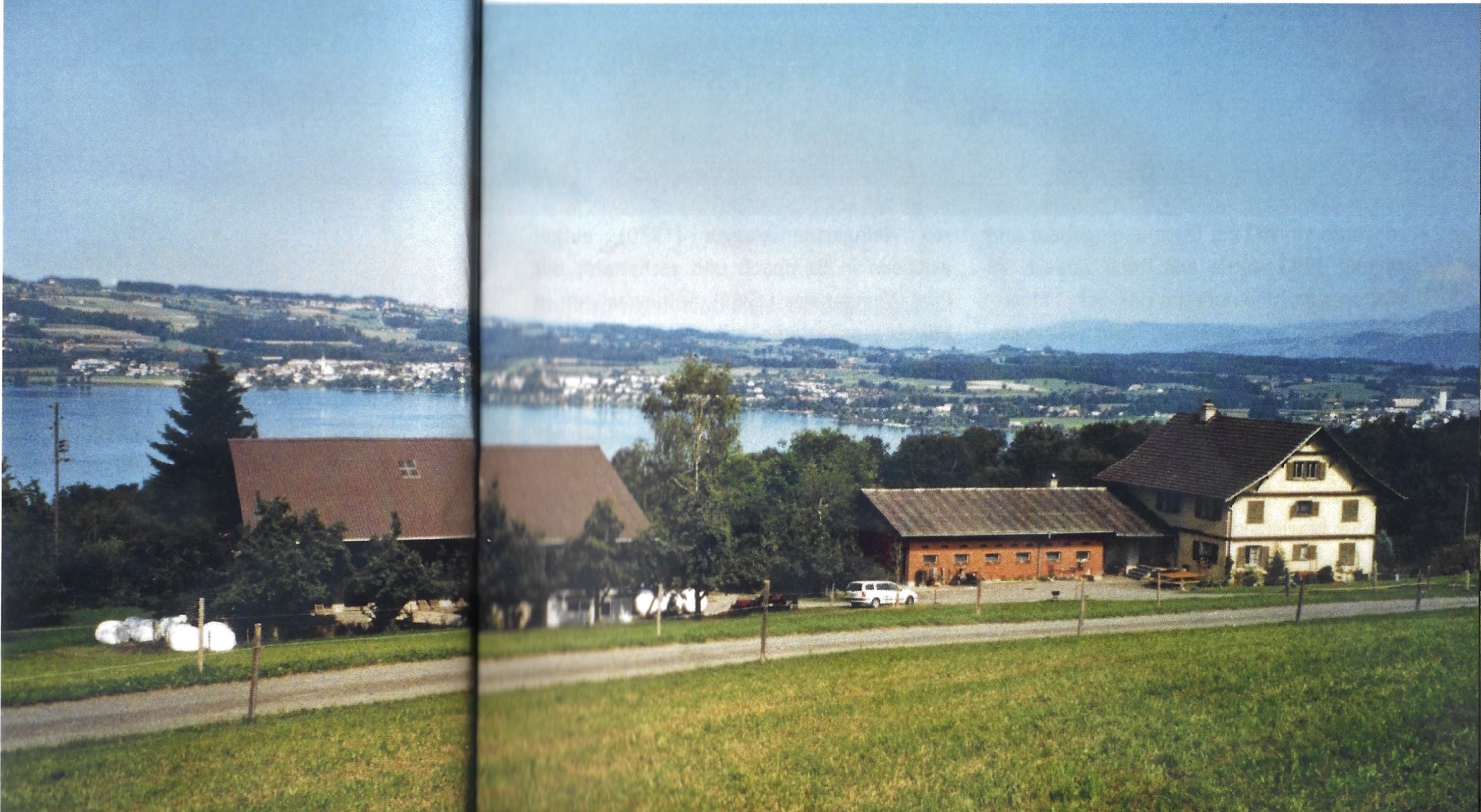
In 1960, the Huprächtigen operation of the brothers Anton and Kaspar Hüsler was split up: the New-Huprächtigen settlement was established around 400 meters from the father’s residence.
In the fall of 1960 Josef Hüsler moved with the cattle to New-Huprächtigen. Josef Hüsler and Rosmarie Vonarburg married in May 1961. They leased the business until 1973, after which they became owners. Little by little the big farmhouse filled up: they gave birth to nine children. In 1986 the Lower-Huprächtigen farm was bought; The owner of this property was Josef Hüsler, born in 1907.
In 1996 the eldest son Sepp took over the business from his father. In the same year the old house and the barn on the Lower-Huprächtigen farm were demolished. A new two-family house was built next to the wash house, which has since been part of the New-Huprächtigen business as Stöckli.
In 1998 Sepp Hüsler and Hanny Suppiger married; In 2000 and 2002 the sons Simon and Dominik were born.
The New-Huprächtigen farm is located in the pre-Alpine hill zone at 623 m above sea level and has an area of 12.11 hectares. Two hectares of forest also belong to the company. Type of production: dairy farming with arable farming.
Hanny and Sepp Hüsler-Suppiger
Chli-Huprächtigen, Weingartner Family
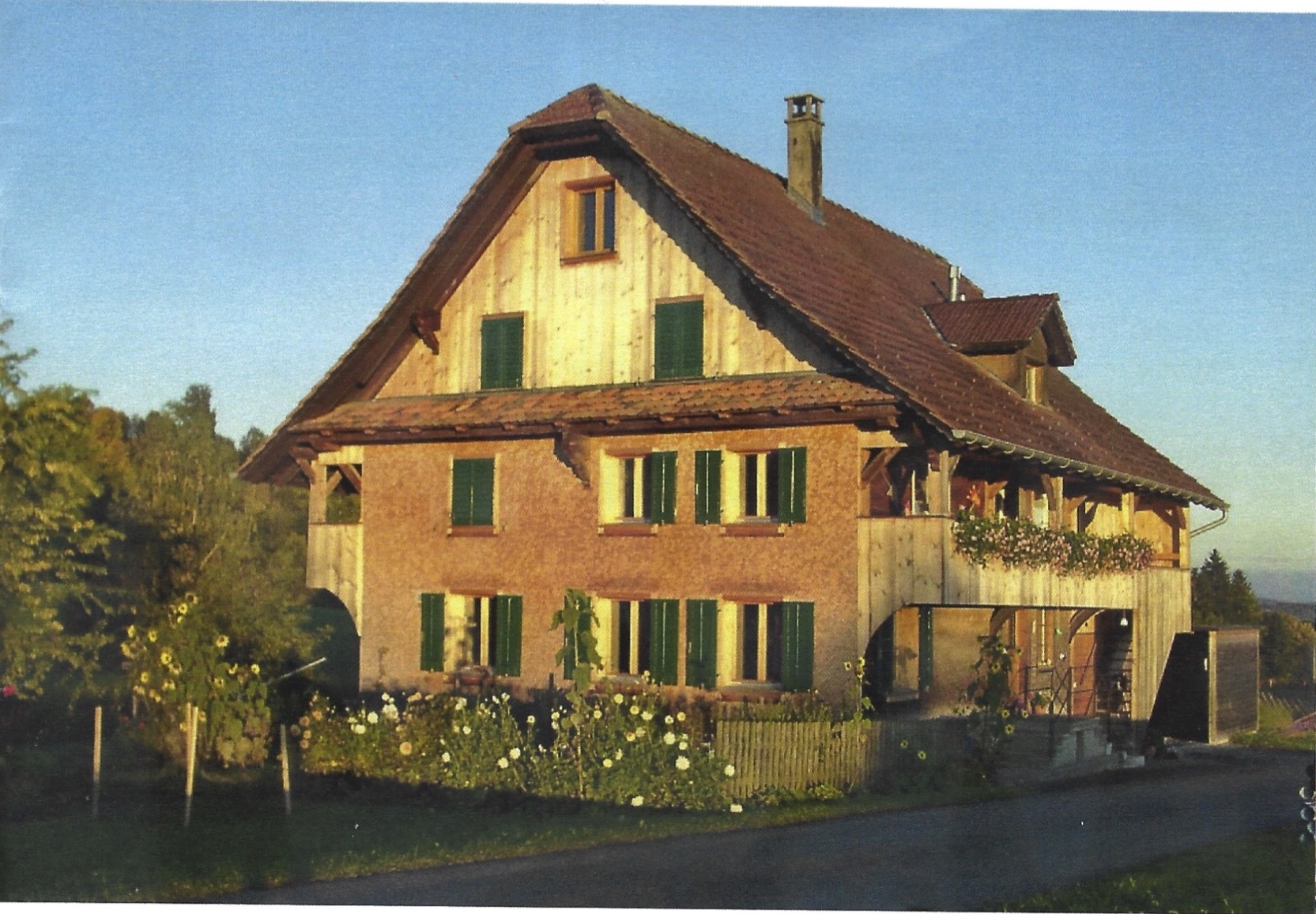
On September 15, 1927, Niklaus Schurtenberger from Malters, living in Haus Flora in Nottwil and Melker near Jost Hürlimann, sawmill, bought the Small-Huprächtigen property from Jost Kiener. The farm had a size of 2 hectares and 43 ares. According to the stories of Josef Schurtenberger, the son of the buyer, there were a lot of fruit trees on the farm at that time.
The farm was run by the Schurtenberger family and later by their son Niklaus. The Gehrig family lived in the small and sparsely furnished apartment on the upper floor. In 1947, Augustin Schaller built a new chimney from the neighboring “Stockschürl” from the kitchen to the roof. The old tiled stove (renovated) is still regularly fired and the fireplace is still in use. At the beginning of the seventies a toilet with shower was installed and in early 1990 the roof was renovated. In addition, not much has been invested in the farm, besides the motor mower and slurry pump.
In September 2002 we were able to buy this building. In order for this to be possible at all, the land rights commission had to approve the parceling out of the building. The land (apart from our property of 13 ares) was bought by the Walter and Marie-Theres Bisang family, Kohlweid. They had been tenants since the mid-1980s; at that time Niklaus Schurtenberger had given up the management, but he lived in the house until shortly before his death.
After the purchase, we began with the extensive remodeling and renovation of the house. We filled up the cesspool and the domestic sewage was connected to the ARA. The water intake was excavated in the 1970s when the Stockschürli water reservoir was being built. Since then, the farm has been connected to the community's water supply.
First we tore down the old stable and converted the threshing floor into an apartment. This resulted in a 2-room apartment. We then moved from the old apartment to the small second home and renovated the rest of the house. All installations were renewed, the house insulated and central heating installed. In 2005 we moved back into the main building; the second home has been rented out since then.
Living in the large apartment: Andrea Weingartner-Aregger (1970), grew up in Sempach and married to Pius Weingartner (1964), grew up in Middle-Huprächtigen, with the children Cyrill Lukas (1998), Benjamin (2000) and MariaElena (2004) . Andrea, trained primary school, is a mother and housewife. She teaches part of the workload at the Nottwil primary school. Pius is a trained agricultural machinery mechanic and works as a technical businessman at Grunderco, Agricultural Machinery Import in Aesch LU. Cyrill is attending the 1st secondary school in Nottwil. Benjamin is in the 6th primary class and Maria has been in the 1st class since last summer.
As mentioned at the beginning, the 1927 purchase agreement concerns the Klein-Huprächtigen property. We found the name “Chli-Huprächtigen” on old maps. We think this address is appropriate and whenever we talk about our home, we speak of "Chli-Huprächtigen".
Andrea and Pius Weingartner-Aregger
Today's residents of Huprächtigen
Upper-Huprächtigen
Hedi and Toni Huber-Frei
Werner Huber
Monika and Peter Huber-Amrein with Marcel, Doris and Lukas
Anton Huber
Middle-Huprächtigen
Monika and Toni Krummenacher-Bähler with Michael
Silvia Graf
Annemarie and Toni Krummenacher-Schmid with Urs and Andreas
Erika Hug
Middle-Huprächtigen
Helene and Toni Weingartner-Ottiger with Selina, Vera, Lucia and Andreas
Rita Weingartner
Simone and Beat Studer with Nadine and Josua
Huprächtigen Cheese Dairy
Yolanda and Otto Birrer creators
Meierisli
Walter Estermann
Large-Huprächtigen
Hans Hüsler
Margrit and Toni Hüsler-Burri
Toni Hüsler
Vreni and Daniel Hüsler-Steiger with Petra and Manuel
New-Huprächtigen
Hanny and Sepp Hüsler-Suppiger with Simon and Dominik
Lower-Huprächtigen
Rosmarie and Sepp Hüsler-Vonarburg
Margrit and Pius Hüsler-Wyss with Celine and Maurice
Chli-Huprächtigen
Andrea and Pius Weingartner-Aregger with Cyrill, Benjamin and Maria Elena
Leila Rady